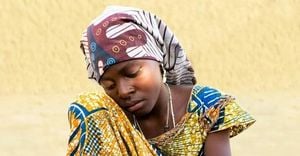Abdulhadi Al-Sayed, a 14-year-old boy from Gaza City, remembers every detail of March 30, 2025, the first day of Eid Al-Fitr. That day, just two weeks after a ceasefire collapsed and Israeli airstrikes resumed, he was on his way home from a rare moment of leisure with friends. Passing children playing in the street, Abdulhadi saw a car pull up—then, suddenly, a missile struck. Seven children and everyone in the car died instantly. Shrapnel tore through Abdulhadi’s right arm and thigh, and as he lay bleeding, a second shell shattered his jaw. He survived, but his life was forever changed.
"I remember that day vividly," Abdulhadi told Arab News from his hospital bed at Mouwasat Hospital in Amman, Jordan, where he’s now receiving reconstructive surgery and rehabilitation. "For months in Gaza, I couldn’t sleep. Every time I woke up, I lived the nightmare still unfolding around me." His story is just one among thousands, as Gaza’s children and families endure the ongoing conflict and a mounting humanitarian crisis.
Abdulhadi’s ordeal didn’t end with the attack. For two days afterward, he lay on a hospital floor in Gaza, among dozens of other wounded, with no bandages, no painkillers, and barely any medical staff. His jaw injuries meant he could only be fed liquids through a syringe—often just tomato paste mixed with water, given the severe food shortages caused by the Israeli blockade. After three months of recovery in unsanitary conditions in a makeshift camp, Abdulhadi was finally evacuated to Jordan on July 1, 2025, as part of a humanitarian mission launched by King Abdullah II. This Jordanian medical corridor, started in February, aims to treat 2,000 critically ill and wounded Palestinian children in Jordanian hospitals. So far, 437 Palestinians, including 134 children, have been evacuated from Gaza to Jordan for treatment, with the latest group arriving August 6, 2025.
Since arriving in Amman, Abdulhadi has undergone complex maxillofacial surgery, including platinum implants to reconstruct his jaw, and plastic surgery to repair facial trauma. He can now eat, speak, and even smile again. More surgeries are planned to remove shrapnel from his hand and reconstruct his right leg, followed by physiotherapy. Despite the clean bed and regular meals, Abdulhadi struggles with survivor’s guilt and longs to be reunited with his mother, who remains in Gaza with her three older sons. "I like being here, but not without my family," he said. His father, Sobhi Al-Sayed, echoed the pain. "I feel helpless when my sons tell me they are hungry. The other day, I could not recognize my wife on a video call because of how much weight she had lost."
Abdulhadi’s family’s struggle is far from unique. Gaza’s humanitarian crisis has reached catastrophic levels. According to Gaza authorities, more than 240 hunger-related deaths have been reported—half of them children—as of August 2025. The blockade and ongoing conflict have devastated Gaza’s infrastructure: hospitals are barely functioning, sanitation and water systems are in ruins, and 1.9 million internally displaced people are crowded into tents, exposed to mounting garbage and unsafe water. As Reuters and AFP have reported, the World Health Organization (WHO) has evacuated over 7,500 Palestinians—including 5,200 children—for treatment abroad since the war began in October 2023, but more than 14,800 remain in urgent need of evacuation. WHO officials have called for faster medical evacuations and the reopening of referral routes to the West Bank and East Jerusalem.
The process of evacuation is fraught with obstacles. Cases are referred by doctors and approved by Gaza’s Health Ministry before being coordinated with host countries and Israel. Bureaucratic hurdles, host country requirements, and occasional Israeli rejections slow the process, leaving thousands without access to lifesaving care. Once children complete their treatment in Jordan, they and their caregivers are returned to Gaza to make room for new patients.
At the Mouwasat Hospital in Amman, Médecins Sans Frontières (MSF) runs a facility that currently hosts 25 Palestinian children from Gaza with critical injuries. Cyril Cappai, MSF’s head of mission in Amman, told Arab News that the comprehensive treatment programs last more than four months and include orthopedic and reconstructive surgery, physiotherapy, occupational therapy, and mental health services. "The injuries we see often require multiple surgeries and a long road to recovery," he said. "We also deal with post-surgery bone infections, which need close monitoring and prolonged courses of antibiotics."
Rehabilitation and psychological care account for 80 percent of the treatment program, helping children and adolescents rebuild their self-worth and adapt to their new conditions. The facility even boasts a 3D printing lab for tailored prosthetics and facial orthoses. Psychotherapy sessions address pain management and trauma, not just for the young patients but also for their companions, many of whom suffer from mental trauma and chronic illness. Exceptions are made for families with young children, allowing mothers to bring siblings along. Play therapy, art classes, and schooling are offered to keep children engaged and help them regain a sense of normalcy.
Ghada Al-Hams, a mother of six, faced an impossible choice when she was called to accompany her 16-year-old son Ammar for treatment in Jordan. She left three children behind in Gaza—a decision that still haunts her. "I left them with no food or water," Al-Hams told Arab News. Her son Ammar was injured in July 2024 when an artillery shell killed his father and nearly severed Ammar’s right arm. Despite limited medical supplies, medics in Gaza saved his arm, but after months without proper care, his right palm remains paralyzed. Ammar was eventually evacuated to Jordan on July 1, 2025. "Ammar was speechless for three months after watching his father die," said Al-Hams. "He was always silent and zoned out. It took him time to start interacting again."
Children like Ammar and Abdulhadi are now receiving not just medical care but also schooling and vocational training in Jordan, slowly regaining their confidence and energy. Yet, as Al-Hams put it, "Every day in Gaza is a struggle for survival. My children would spend four hours in line for water, then another for flour. If we managed to get food that day, we never knew when we’d find any again. Now my kids are living their childhood again."
The scale of suffering in Gaza extends far beyond those able to escape. On August 3, 2025, seven-month-old Hasan Ahmed Felfel received limited treatment for severe malnutrition at Abdel Aziz al-Rantisi Hospital in Gaza City, according to Common Dreams. Amnesty International published testimonies on August 18, 2025, highlighting what it described as Israel’s "systemic and intentional" campaign of starvation in the Gaza Strip. Over 682 days of conflict, hundreds of Palestinians—including more than 100 children—have died of malnutrition. Amnesty alleges that Israel’s policies are "deliberately designed to inflict conditions of life calculated to bring about the physical destruction of Palestinians in Gaza," and calls on the international community to uphold its moral and legal obligations to end what it calls an ongoing genocide.
The International Court of Justice is currently examining whether Israel’s actions constitute genocide, and the testimonies gathered by Amnesty include harrowing accounts of hunger, disease, and violence at aid distribution sites. One emergency doctor at al-Shifa Hospital told Amnesty that many patients "would be leading reasonable lives were it not for the combination of starvation, destruction, and depletion of the healthcare system, unsanitary conditions, and multiple displacements under inhumane conditions." Amnesty’s senior director, Erika Guevara Rosas, urged the international community to act: "There must be an immediate, unconditional lifting of the blockade and a sustained ceasefire. The impact of Israel’s blockade and its ongoing genocide on civilians, particularly on children, people with disabilities, those with chronic illnesses, older people, and pregnant and breastfeeding women is catastrophic and cannot be undone by simply increasing the number of aid trucks or restoring performative, ineffective, and dangerous airdrops of aid."
As Gaza’s children continue to bear the brunt of war, displacement, and hunger, the stories of Abdulhadi, Ammar, and countless others serve as painful reminders of the urgent need for lasting solutions and international accountability. For now, a handful of children find hope and healing far from home, while thousands more wait—wounded, hungry, and holding onto whatever hope remains.





